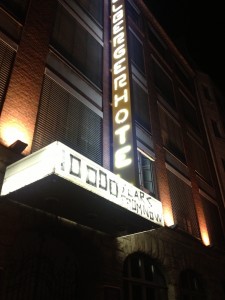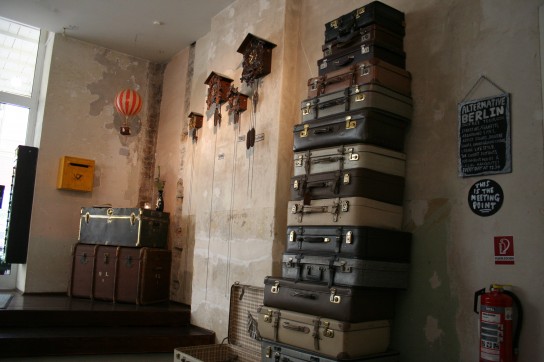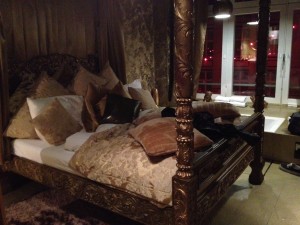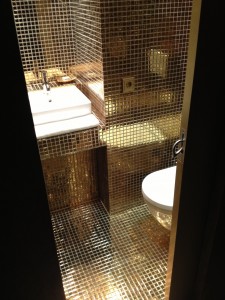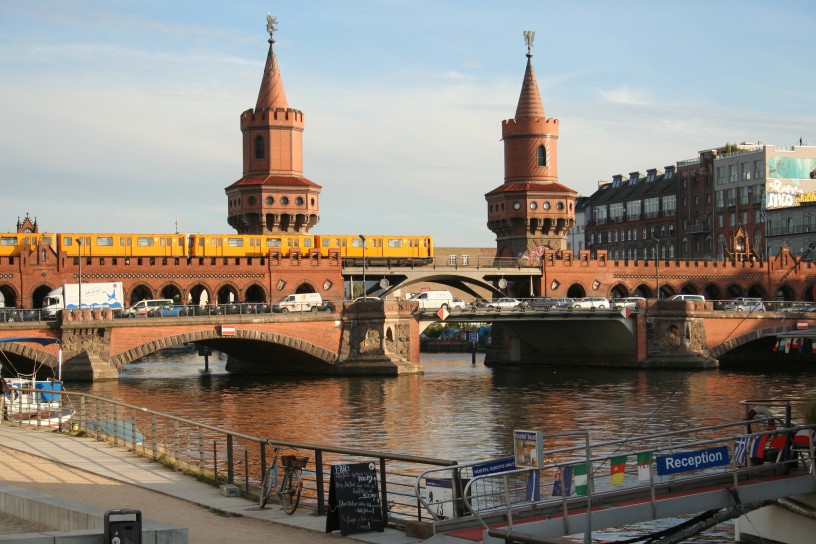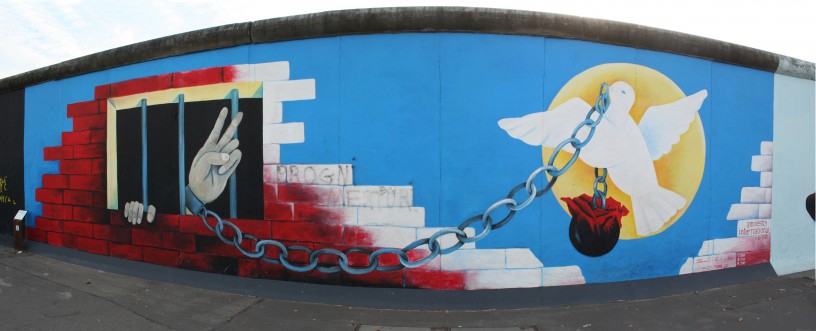The post Michelberger Hotel, Berlin appeared first on Confiscated Toothpaste.
]]>When visiting new cities, it certainly pays to research your accommodation options. So many travellers choose a place based only on price or location, but a room can be so much more than just a place to rest your head after a day of sightseeing. It can be part of the travel experience itself.
The Michelberger Hotel in Berlin is one such place. Its setting is as quirky as the hotel itself- in gritty Friedrichshain in the former East Berlin, close to the amazing East Side Gallery and just across the river from eclectic Kreuzberg. The area is great for exploring if you love street art, techno clubs, cafes or kebabs, or if you’re feeling somewhat Ostalgic. If this kind of thing ain’t your bag, and you just want to do the big cultural monuments, you might prefer to stay right in the city centre. I’ve done both on different visits to Berlin. Mind you, the Michelberger Hotel is very well connected to all areas of Berlin, being situated right outside the Warschauer Strasse U and S-bahn stations which can take you into the city in 10 minutes and just about anywhere else you want to go.
Looking for a place to stay short notice in the days after Oktoberfest, I called up from Munich and the amiable (and fluent English speaking) girl who answered was happy to oblige. “There is only one problem,” she said, “for the first night, you will have to stay in the Golden Room as there is nothing else available.” This was my first hint that this wasn’t to be a regular hotel stay. Though the price was higher in the Golden Room than in the regular budget rooms (dubbed “Cosy Rooms” by the hotel), I was intrigued and agreed immediately.
First things first, check-in was wonderful and included a cute map of Berlin that the hotel has produced itself, showing all the attractions that are worth seeing in Berlin. The map even shows you where you can go for a nice run along the Spree riverbank closeby. The lobby of the hotel is also incredible- it’s like going round to your best mate’s lougeroom, if your best mate was extremely well read and had an incredible book selection. Comfy couches are everywhere, and bookshelves, and people are actually hanging out and mixing here as they would in a hostel. Big points for this well-thought out lobby. There’s also a bar/cafe that serves cheap and delicious soups and cakes.
My next stop was the Golden Room and all I can say is wow. This is the luxury end of the hotel’s appointments and the room was resplendent in gold walls, floor, ceiling, bathroom tiles and shower, along with a huge porcelain dalmation and a gold palm tree. Then there was a large bed piled with golden pillows and a bathtub overlooking the central courtyard. The bathtub had statues of corgis beside it. The vibe was slightly perplexing but strangely uplifting and very Berlin. It’s a pity I was there alone as this room would be a lot of fun for a couple.
I must say I enjoyed my time in the Golden Room so much that I was not looking forward to moving to one of the Cosy Room on day 2. These rooms are at the other end of the spectrum, designed for budget travellers or people who would otherwise be staying in a hostel, and they are small, basically just a bed and a shower. It definitely does the job though, and then you have more money to spend at the local nightclubs or bars, or with the (very good) hotel masseuse. My Cosy Room also had a view over the East Side Gallery, and it was a buzz to wake up every morning with a view of the Berlin Wall.
While the hotel corridoors are somewhat depressing, the only real negative aspect of my stay at the Michelberger Hotel was the wi-fi. It worked sporadically on my first day there, but the next day was a public holiday so they couldn’t get a technician. The day after the public holiday the technician was busy. In the end, with a four day visit, I only had wi-fi on Day 1 and it was not good wi-fi. I understand that the breakdown timing was somewhat out of their control, but for a person who works while travelling reliable internet access is essential. I spent nearly as much on mobile roaming as an extra night in the hotel would have cost me. This is not good enough and the hotel loses a full extra point from me for this bummer.
The post Michelberger Hotel, Berlin appeared first on Confiscated Toothpaste.
]]>The post The Secret Stasi Prison in the Former East Berlin appeared first on Confiscated Toothpaste.
]]>This is not the most uplifting way to spend Easter Sunday, I think as I ride on the tram from Alexanderplatz to Lichtenberg. But it’s a bitterly cold, snowy spring day in Berlin and the novely of chocolate eggs has worn off. I hate being reminded of the capability of humans of savagery and tyranny toward fellow humans. It makes me angry and depressed. But the Stasi prison has been recommended to me by several people in the highest possible terms and there’s a part of me that wants to face these monuments, that wants everyone to face these monuments to our troubled past so that we can be appalled and educated and work together to stop these things happening again.
The tram is warm and comfortable and the snowy landscape is pretty as it slides past. I begin to forget the sub-zero temperatures outside and secretly want the tram ride to go on forever. But after half an hour or so we reach the stop and I emerge into a cold and windy environment. The tram grinds off into the background. It’s too cold to stand around waiting for another one back into town and to the dismay of my empty stomach all of the little shops and restaurants in the nondescript modern buildings are closed for the public holiday. There’s nothing else for it but to begin walking down the long street that leads to the Hohenschönhausen prison. At first the landscape is suburban, but then the first few old administrative buildings of the facilty come into view and the view becomes grim. If this were happening thirty years earlier, I’d be walking off the edge of the map.
A Web of Lies, Denial and Paranoia
This whole area was part of the web of lies, denial and paranoia spun by the former East German Communist Ministry of State Security, the Stasi. Officially, it did not exist. It was not marked on any maps. The outside world didn’t know much about it and East Germans didn’t know much about it. Because of this, when the wall fell the prison was not stormed by angry citizens like other Stasi facilities. As a result, prison officials had time to destroy documented evidence of their crimes and it is largely only thanks to anecdotes from former prisoners that the truth of what happened in Hohenschönhausen has emerged.
From the outside, it feels like a real prison. Everything is intact- this is no pleasure cruise or tourist trap. A guard greets me at the heavy metal gate. “English tour?” I ask hopefully. He directs me in German to a small reception area further down the yard. I’m happy to find a tiny, simple cafe where I wolf down a cold sausage, gherkins and a can of Pepsi before our group of curious strangers is herded off to meet our guide. I am shocked when he introduces himself as a former inmate. For one thing, he doesn’t look “old” enough. He’s barely fifteen years older than me. He does have the blank stare and demeanour of someone who might have been robbed of their liberty and dignity, but it might just be the stress of reiterating the past on a cold afternoon in a foreign language. He has some scars that might be evidence of physical torture or might equally be from a motorbike accident. He is consistently brief, matter-of-fact and unhalting in his description of the atrocities that took place in the prison. “This device is designed to drip cold water repeatedly on your head. After some time, you feel as though a hole is being drilled through your head and it drives you slowly insane,” he calmly describes Chinese water torture, before moving on to the next description just as you come to terms with your horror.
The U-Boot
“You are free to take as many photos as you please, even of me,” is the first thing we are told as we enter the prison. To my mind, the message is clear that this man wants the history of this Stasi prison to be broadcast. I rattle off shots but the pace of the guiding is fast, and several times I am left behind and I race down the halls, my heart beating as I try to find where the group has gone and avoid being lost in this god-forsaken place.

A device used for Chinese water torture. The inmate was held in stocks by the neck. The lower receptacle was filled with water, forcing the prisoner to keep head up for fear of drowning, while water was dripped steadily onto their head from the upper receptacle
The oldest and most sadistic part of the prison (and where the Chinese water torture took place) is a series of underground cells called the “U-Boot” or “Submarine”. This area was used in the Stalin years by the Soviets after the occupation of Berlin and then by the Stasi in 1951 onwards. A set of stairs from the prison courtyard leads down to the bleakest underground environment you could imagine. Long corridors stained with rust and mildew connect with many cramped concrete cells. Light from the outside world is almost non-existent. The cells are small and dominated by low wooden benches where prisoners slept. The cells were overcrowded with prisoners. A metal can with a toilet seat served as a toilet, which was used in front of all the other inmates in the cell.

A solitary cell in the U-Boot complex. Obviously a bed would take up most of the available area. I can’t begin to comprehend the horror of being trapped in this cell.

The walls, floor and ceiling covered with rubber from conveyor belts, this cell was heated and totally dark. It’s hard to imagine the terror of being locked inside.
But it is the solitary cells in this compound which are the most frightening. Some of them are so small as to barely fit the bed and nothing else. Some of the cells, used for punishment and torture, have only enough room for one to stand up. The prisoner would be left in there without space to sit or lie down until it was deemed that he or she deserved to return to a regular cell. Another room was covered floor to ceiling in black rubber cut from conveyor belts. This was used to heat the cell and make it humid. As one female inmate confided, “When I arrived they asked if I wanted a warm cell or a cool one. It was cold outside so I said I’d prefer a warm one. They put me in a cell where the temperature was maintained above 40°C. I sweated constantly.”
Indeed, our guide’s own grandmother had been imprisoned in the U-Boot. “She was charged with subverting the regime, of conspiring to start a third world war,” he explained. “Why would a grandmother be trying to start a war? She was 75 years old.”
The New Wing and a New Era of Oppression
In the reforms following Stalin’s death in 1953, the U-Boot ceased being used to house prisoners and a new prison building was built above ground in the late 1950s. Conditions improved somewhat, though the paranoia of the regime increased. An attached garage was used to park secret delivery vans which looked like tradesmen’s vehicles but were used to kidnap opponents, even illegally from West Berlin. The garage is filled with bright lights to dazzle incoming prisoners after coming out of the dark van, prior to their interrogation.

Cells line the corridor of the new part of the prison, built after the death of Joseph Stalin. The wires lining the walls form an alarm system which could warn prison guards of a suicide attempt or an aggressive prisoner.

A cell in the new part of the prison. Guards would abuse the prisoners through the hole in the door, sending them slowly crazy

“I thought the regime would last my whole life, and I did not want to spend my life behind a wall. They described my high forehead, my hair, my teeth. The man said I was of above average intelligence. They talked about all my past behaviour and tried to predict my future behaviour. They said I was a high risk of repeat offending- they were right about that. They were very good psychologists.”
Rather than build a society and state in which people would not emigrate from and would be happy to live in, the government chose to effectively imprison the population through the building of the Berlin Wall in 1961. The new prison building from this point onwards was primarily used to house those attempting to escape the state, though it was also used to inter political opposition, dissidents, religious folk and anyone whom the increasingly paranoid Stasi considered “suspicious”. At the peak of the Stasi’s invasive practices, around 1 in 7 people were spying on behalf of the Stasi. Some people ended up in the prison simply because their neighbours envied or despised them. There was nobody you could really trust and people ceased trusting even those closest to them. On occasion the Stasi used this to their advantage. “Perhaps the Stasi would start a rumour amongst your friends that you were working for them,” our guide explains. “Whether your friends really believed the rumour or not didn’t matter. You would find that suddenly you had no friends anymore.” Another story concerned a woman brought in for interrogation being given her favourite tea by the interrogators. The officials noted that she faltered in her answers as the tea was brought forth. “What is wrong, Mrs _____?” they asked. “Is this not your favourite tea? We wanted you to be comfortable.” The woman’s betrayor? Her husband.
Entrapment and Interrogation
The new building does not have quite the same dungeon atmosphere as the U-Boot, but it’s grim in other ways. The lineoleum, laminated desktops, carpets and telephones are right out of the textbook of depressing 1970s/80s decor. The cell doors are thick with small windows through which the guards could taunt you. Suicide was not an option and indeed great lengths were taken to prevent it occurring. In the basement are several padded cells. I always had a quaint mental picture of a padded cell being upholstered like a sofa. Of course the reality is so much darker. The cells are round and almost pitch black and the padding is thick, black and grimy. I gingerly press a finger into it and reluctantly it slightly gives way. Along the walls of the corridor are insulated copper wires connected in series with banana plugs, supported on picture hooks. If there was a suicide attempt, or a guard was attacked, the alarm could be sounded by pulling on the wires and breaking the circuit. This would send other guards running. Prisoners were walked along the corridors in isolation. If another prisoner was being escorted in the opposite direction, one prisoner would stop and be faced towards the wall so that they could never lay eyes upon each other. At junctions, traffic lights on the ceiling indicate whether it was ok or not for a prisoner to proceed. Rather than the medieval physical torture of the earlier period, psychological torture seemed to be the order of the day in the 70s and 80s.

Entrance to a padded cell in the basement of the prison. The suicidal or those driven to self harm were placed here.
Our guide tells us his own chilling story, briefly, calmly. “It was 1985 and I was 18. It was only four years until the end of the GDR. But how could I know that? I felt at that moment, as though the regime would last my whole life,” he says, “and I did not want to live my life behind a wall”. He tried to escape and was captured and brought to the Hohenschönhausen prison. He was interrogated and spent a year in confinement. When the wall fell some years later he was able to access the files the Stasi had kept on him. “They described my high forehead, my hair, my teeth. The man said I was of above average intelligence. They talked about all my past behaviour and tried to predict my future behaviour. They said I was a high risk of repeat offending- they were right about that. Some people didn’t mind living under the regime. There were some good things about it- everybody had a job and childcare. Some people even liked it. I was not one of those people. They knew that well. They were very good psychologists.”

An interrogation room. The investigator would sit behind the desk slightly higher than the accused. Behind the accused, unseen, sat another interrogator. The objective was to make the accused feel as though he or she was between a rock and a hard place at all times.
As testament to that skill in psychology, there is another anecdote about parents being brought in for questioning. As the interrogation proceeded, the phone would ring on the official’s desk. “I see,” he’d say, “am I understanding this correctly? The children have been placed under the care of the state? Okay thankyou.” Perhaps the interrogator would be only bluffing. But there were occasions where forced adoptions did take place, and the parents and children never saw each other again and indeed had no knowledge of the others’ fate. Other methods were more subtle yet just as sinister. The Stasi could access any building in the city they desired. “Perhaps you would come home from work and find furniture rearranged or objects where you knew you hadn’t left them. Perhaps you had a banned book or some protest leaflets. You might find them sitting on a table where you knew they didn’t belong. Then you knew the Stasi were onto you and you would be filled with fear.”

A so-called “exercise yard” or outdoor cell. There was barely enough room to take this shot. Snow and rain can enter through the open ceiling.
Before finishing, the tour passes through the old prison infirmary and the “exercise yards” or “tiger cages”. Tiger cages is indeed a more apt description, because these open pens are barely bigger than some of the cells. In reality these cages with high walls and cyclone fence-ceilings were used as another punishment for belligerents, the poor sods being exposed to the rain and snow for the duration of their time in there.
A New Life Free from Psychological Trauma
I am dying to ask my guide dozens of questions about his thoughts and feelings but as the prison yard empties out, I manage just one- how did you attempt to escape? “I tried to cross the border from Hungary to Austria, but they caught me,” he says simply, referring to the Iron Curtain separating East from West. He clearly doesn’t want to discuss further, and I don’t want to ask him whether his brevity is due to psychological trauma or just wanting to be home in front of the fire with his family on a freezing day. Quite possibly a bit of both. In the end, this tormented population were just regular people trying to lead regular lives that we in the West took for granted and that they are now finally able to enjoy too. Many of them were forced into extraordinary situations as an unfortunate byproduct of the Cold War. Many people lived and died under subsequent fascist and totalitarian regimes. The world’s energy blunted by two World Wars, under the threat of nuclear holocaust, and blinded by the effectiveness of secrecy even to this day, many of the perpetrators of the crimes within Hohenschönhausen went unpunished. Incredibly, the head psychologist and several of the prison guards still live in the local area.
My harried guide disappears hurriedly. As the prison gate clangs shut behind me, the last one to leave for the day, I realise that were it not for the efforts of regular people demonstrating against intolerable oppression that this site could so easily be, to this day, the remand centre of the hated Stasi.

An administrative building of the surrounding restricted area, now suitably dilapidated and part of Berlin’s past.
The post The Secret Stasi Prison in the Former East Berlin appeared first on Confiscated Toothpaste.
]]>